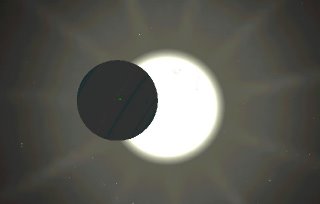Thursday, February 01, 2007
The Atmosphere of Far Off Planets
 In 1835 Dr. August Comte said humans could never know the chemical composition of the stars. About twenty years later Kirchhoff invented the spectroscope, and the chemical composition of the stars was laid bare in bands of light.
In 1835 Dr. August Comte said humans could never know the chemical composition of the stars. About twenty years later Kirchhoff invented the spectroscope, and the chemical composition of the stars was laid bare in bands of light.Then it was thought we would never know if there were planets around other suns, now we have over 200 of the blasted things.
HD 209458b is an iconic exoplanet, because it is one of only two exoplanets that have had some of the composition of their atmopshere determined. This is because it is a transiting Exoplanet, where it passes in from of its sun from our point of view, and we can take spectra of it. Not so surprisingly, there is hydrogen, but also oxygen, carbon and sodium. But more than that, being close to its star it is backingly hot, and its atmosphere trails behind it like a comet.
But until now, researchers couldn't accout for how fast it was leaking gas. Now a new paper in the journal Nature has reported measurements of a hot layer of hydrogen in the planets atmosphere that drives the loss of gas. In a decade we have gone form being able to detect exoplanets, to being able to determine the composition and structure of their atmospheres. That is cool (or hot).
Comments:
<< Home
It's amazing how far we have progressed since we first were able to view the stars!
I wonder how long it will be until we can actually determine whether or not other Earth-like worlds exist?
I wonder how long it will be until we can actually determine whether or not other Earth-like worlds exist?
Probably a while yet. The current instruments aren't sensitive enough for earth-like worlds, although COROT may find large rocky worlds. We have to wait for the terrestrial planet finder missions.
Post a Comment
<< Home





 Click to read about or order
Click to read about or order Click to read about or order
Click to read about or order Click to read about or order
Click to read about or order Click to read about or order
Click to read about or order




